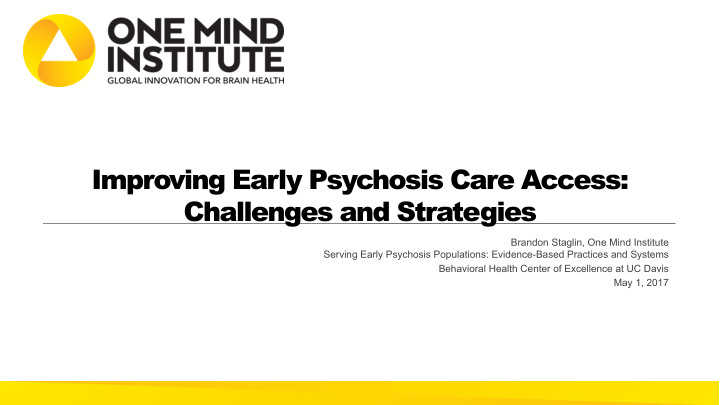



Improving Early Psychosis Care Access: Challenges and Strategies Brandon Staglin, One Mind Institute Serving Early Psychosis Populations: Evidence-Based Practices and Systems Behavioral Health Center of Excellence at UC Davis May 1, 2017
Challenges to Treatment Access 1. Community unaware of nature of psychosis, of programs/efficacy 2. Too little program capacity 3. Insurance does not fully reimburse 4. Distances, time commitment make consistent treatment inconvenient 2
Strategies to Improve Access 1. Educate the public 2. Build a community culture of support 3. Advocate with officials & insurers, using data 4. Embrace digital technologies 3
Challenge 1: Unawareness • Fear-inducing misconceptions: – “Mental illness is the sufferer’s fault.” – “Mentally ill people are different and dangerous.” – “Mental illness is a life sentence.” • Results: – “Different” youth disciplined or ostracized – Youth in crisis afraid to seek, and do not get, care 4
Strategy 1: Educate • Offer programs to teach: – Psychosis is no one’s fault – Psychosis is highly treatable, and remission common – Coordinated Specialty Care (CSC) programs emphasize helping clients attain their goals – There may be a CSC program nearby • Examples: Strong365, NAMI programs 5
Strategy 2: Build a Culture of Support • Wider networks of trust = stronger safety nets • Support programs in which youth work, play and learn cooperatively • Examples: Sporting teams, music bands, volunteer teams, outdoor education 6
Challenge 2: Too Little Capacity • For some programs, insufficient funding to build to capacity – Even in CA, only ~1/2 of counties with CSC programs have applied MHSA PEI funding to them – Medicaid does not cover every component of CSC – Medicaid does not cover Prodrome treatment • Result: Programs only treat a small fraction 7
Challenge 3: Insurance Non-coverage • Commercial insurance: – does not cover every component of CSC – does not cover prodrome treatment • Parity laws are only weakly in effect • Result: Families that rely on private insurance can’t access adequate care 8
Strategy 3: Advocate, with Data • CSC is expensive to support • Need to prove that CSC saves costs downstream • Current data: ~50% drop in hospitalizations • Collect and analyze outcomes data across programs to strengthen case • Examples: MHSOAC reporting website, EPI-Plus 9
Challenge 4: Inconvenience • Some families live too far from a CSC center for regular visits • Even families who live close by may have little time to allocate to therapeutic visits 10
Strategy 4: Embrace Technology • Cognitive Training software has been tested remotely: Improvements in function & health • Online CBT has been shown effective • Software to enhance patient-clinician communication: promising results • Examples: BrainHQ, PRIME, Mobi 11
Recap Challenges Strategies • Unawareness • Educate • Lack of Capacity • Build a culture of trust • Insurance non- coverage • Advocate, with data • Inconvenience • Embrace technology 12
THANK YOU! Contact me: Brandon Staglin brandon@onemindinstitute.org www.onemindinstitute.org
Recommend
More recommend